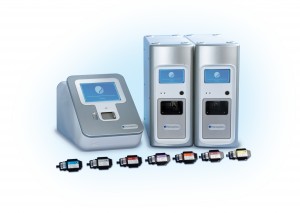Nanosphere’s Gram-Positive Blood Culture Nucleic Acid Test (BC-GP) gives pathologists and clinical laboratory managers a new tool in the diagnosis of septicemia
One of the more challenging diseases to diagnose and treat is septicemia. Traditional microbiology methods typically require two or three days before an accurate diagnosis can be made. Now there is news of a rapid test for bloodstream infections that can allow a hospital clinical laboratory to deliver an answer to physicians in as little as two hours.
It was just last week when the Food and Drug Administration LINK (FDA) granted a de novo petition to allow Nanosphere, Inc., of Northbrook, Illinois, to market its Gram Positive Blood Culture Nucleic Acid Test (BC-GP). This assay is design to be run on Nanosphere’s Verigene automated system. Because the time-to-answer is as little as two hours, this diagnostic technology has the potential to trigger swift changes in the current standard of care for diagnosing and treating blood infections.
New Rapid Genetic Tests Will Add Value for Clinical Laboratories
For microbiologists, pathologists, and clinical laboratory managers, Nanosphere’s use of advanced molecular and genetic testing technologies in its BC-PG assay is just the latest example of how new medical laboratory tests will deliver additional value to physicians and patients. The benefits of this assay include:
- The BC-GP test is a multi-analyte assay that can diagnose 12 different types of bacteria associated with bloodstream infections;
- Time-to-answer is between two and two-and-a-half hours. This is a substantial reduction from the two to three days typically required for more traditional microbiology procedures to produce an answer; and,
- The BC-GP test will simultaneously detect multiple markers for antimicrobial resistance, including the mecA, vanA, and vanB genes that confer resistance to the antibiotics methicillin/oxacillin and vancomycin.
It is important to note that Nanosphere’s BC-GP assay is designed to detect gram-positive organisms. The company says it is working on a separate medical laboratory assay that will detect gram-negative organisms.

Bloodstream infections are associated with up to 1.6 million hospitalizations each year and associated with $15.6 billion in costs. Pictured above is the Verigene System manufactured by Nanosphere. Last week, the FDA cleared Nanosphere’s new assay for rapid detection of bloodstream infections for market. (Image by Nanosphere, Inc.)
Pathologists and clinical lab managers understand that bloodstream infections are a major source of inpatient morbidity and mortality. Septicemia is associated with up to 1.6 million hospitalizations each year.
A story in the International Journal of Antimicrobial Agents noted that hospitals in the United States report about 30,665 deaths per year from bloodstream infections. It is believed that up to 50% of these infections occur in hospital critical care units. The Agency for Healthcare Research and Quality (AHRQ) says that septicemia is also the most expensive cause of hospitalization, totaling $15.4 billion in aggregate hospital costs annually.
Nanosphere’s focus on detection of gram-positive bacteria is confirmed by the statistics. Upwards of 65% of bloodstream infections are caused by gram-positive bacteria. Gram-negative microbes and fungi cause about 25% and 9.5% of these infections, respectively.
William Moffitt, CEO of Nanosphere, stated that, “Patients suspected of deadly infections can now get a first-ever diagnostic tool for detecting disease-causing bacteria while simultaneously determining antibiotic resistance within the critical timeframe for making and adjusting initial treatment.”
Scalable Lab Test Solutions of Hospitals of All Sizes
Finally, another benefit of this new diagnostic technology is its scalability. Nanosphere believes that the economics of its BC-GP assay and Verigene system will allow a hospital of almost any size to set up and offer this test to its physicians. The Verigene system is benchtop-sized and that should allow it to fit in almost any hospital laboratory.
Dark Daily believes that these features are representative of the coming next generation of molecular diagnostic tests and genetic assays. In vitro diagnostics (IVD) manufacturers will be bringing smaller, self-contained lab instrument systems to market. Many will be “load and walk away,” thus improving the productivity of medical technologists and clinical laboratory scientists.
—By Mark Terry
Related Information:
FDA clears rapid NAT that identifies Gram positive bacteria in blood cultures
Medicine Leaps Forward with FDA Approval of Rapid Result Bloodstream Germ Test
“Nanosphere Receives FDA Authorization to Market its Gram-Positive Blood Culture Test.”




What an incredible idea, though why would this solution be for gram negative bacteria as well?
Still amazing, since most of the blood borne infections I have seen in my career have been Staph. Aureus.
And better yet, the physician and patient wouldn’t need to wait on a full susceptibility assay to be performed!
Amazed.
Now, we wait on a full scale version that is capable of differentiating gram negative species as well.
=)